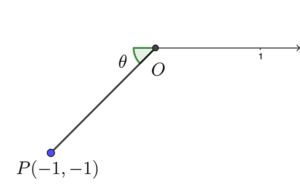Ans: D
Since the coordinates of the reflection image of $Q$ with respect to the $y$-axis are $(5,-1)$, then the coordinates of $Q$ are $(-5,-1)$.
Since the coordinates of the reflection image of $Q$ with respect to the $y$-axis are $(5,-1)$, then the coordinates of $Q$ are $(-5,-1)$.
Since $P$ is translated leftwards by $4$ units to $Q$, then the coordinates of $P$ are $(-1, -1)$.

By Pythagoras Theorem, we have
$\begin{array}{rcl}
OP^2 & = & 1^2 + 1^2 \\
OP^2 & = & 2 \\
OP & = & \sqrt{2}
\end{array}$
Also, we have
$\begin{array}{rcl}
\tan \theta & = & \dfrac{1}{1} \\
\tan \theta & = & 1 \\
\theta & = & 45^\circ
\end{array}$
Therefore, the polar coordinates of $P$ are $(\sqrt{2}, 45^\circ + 180^\circ)$, i.e. $(\sqrt{2}, 225^\circ)$.

